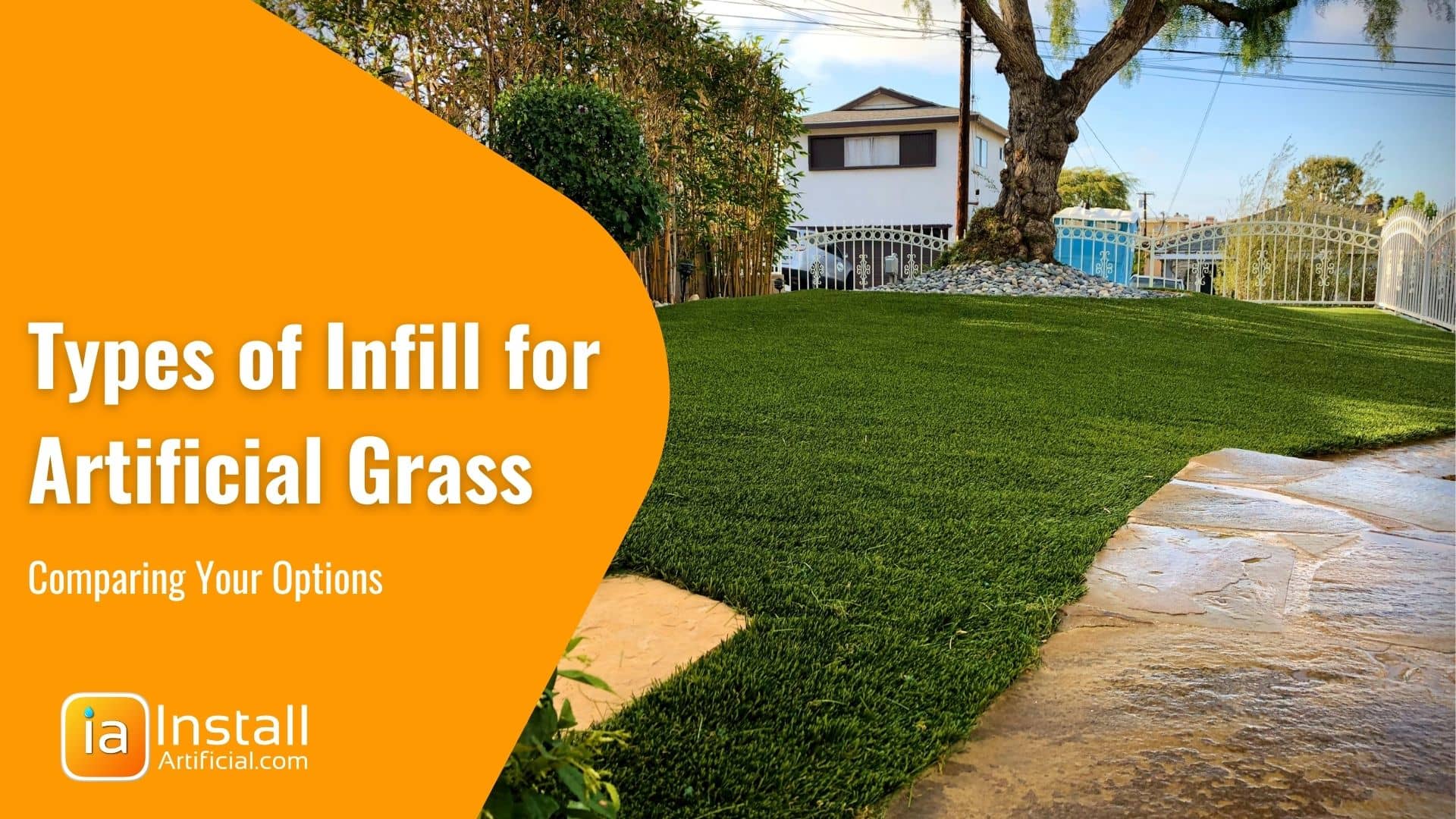
What is artificial turf infill and why is it necessary in most artificial grass installations? Learn the different types of infill and compare your options to decide...
Is artificial grass right for you? Find the answers to the most important questions before you buy or install artificial grass. Learn key terms, the different types, shapes, infills, and installation steps of synthetic turf. Watch videos with professional opinions on fake grass. Updated on 12/08/23.
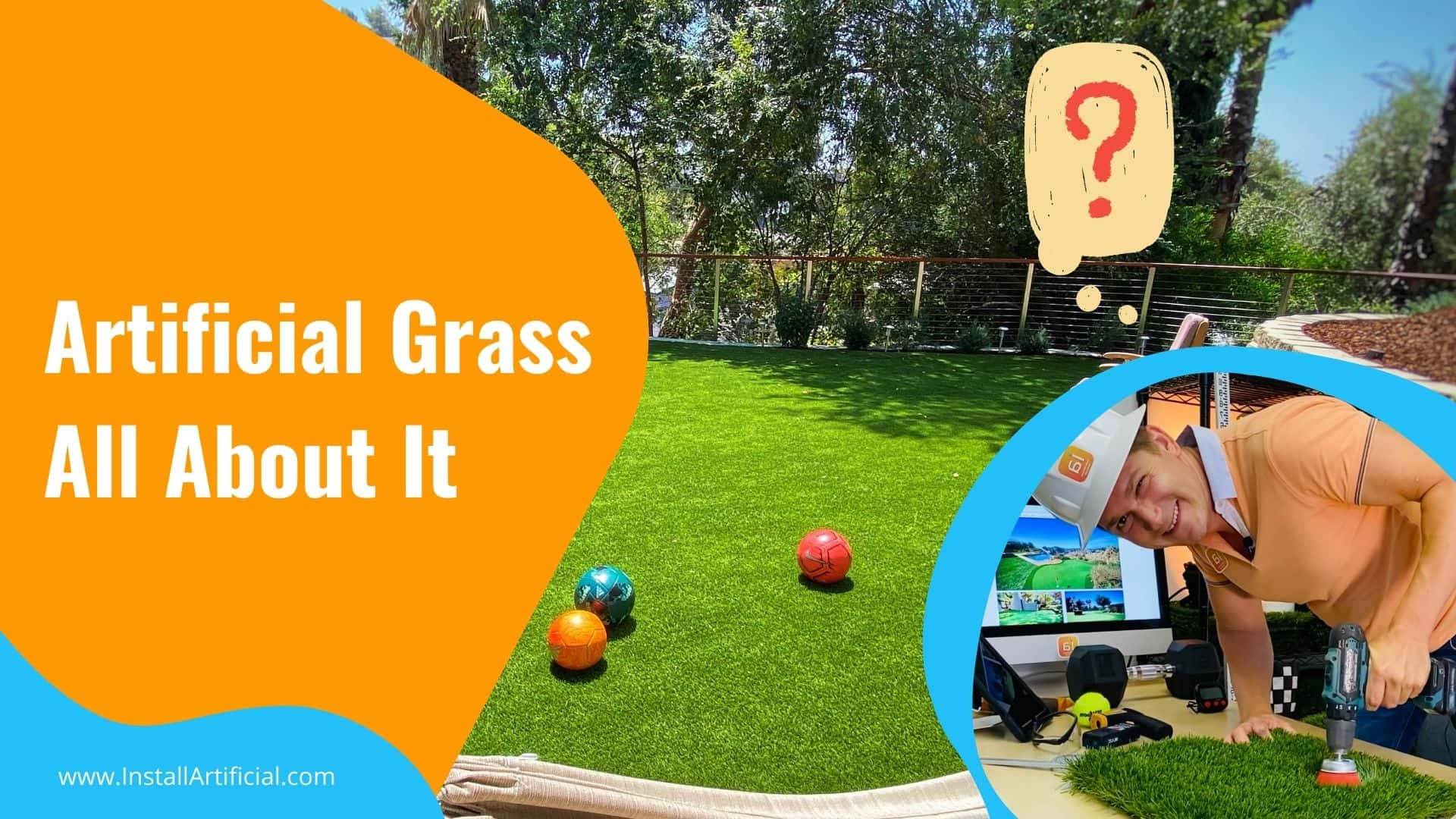
Before you learn the ins and outs of artificial grass, it's important to determine if fake grass installation is even right for you. There are 5 common myths about artificial grass that many contractors and installers will lead you to believe:
This is not true. While the components of artificial grass individually can be recycled on their own, once installed, artificial grass is extremely difficult to recycle. The infill becomes so embedded within the surface that it's nearly impossible to separate these materials in order to recycle them. At the moment, there is not one waste center in the state of California that has the capability to recycle artificial grass. Visit our artificial turf recycling page to learn more about our initiative and support the cause by signing our petition below!
 2. Artificial Grass is Maintenance-Free
2. Artificial Grass is Maintenance-FreeWhile artificial grass requires much less maintenance than a natural lawn, it's not true that there are no maintenance requirements. This is especially true for areas where pets will be present. Pet turf will need to be rinsed and sanitized consistently to prevent bacteria and odor build-up. Other maintenance includes the occasional brushing, leaf blowing, and redistributing infill as needed.
Any plastic material will become hot when exposed to heat and synthetic grass is not an exception. Contractors will pitch you cooling infills and promise low temps but artificial grass will still become warm under the mid-day sun. This can be combatted by installing shade awnings, watering down the lawn, and opting for less dense and shorter grass that provides more airflow between the blades.
Most suppliers offer very vague warranties that will give them leverage in the event a customer submits a claim. Often, these warranties are on a sliding scale and dilute in value as the years go on. Artificial grass warranties also only cover the turf material itself, not the re-installation. Manufacturers will basically give you a patch of grass that can fix the affected area, and typically by this time the surrounding turf has faded a bit so the patched repair is evident. These warranties only cover product defects and regular wear and tear will not be covered. If the product is not installed to the manufacturer's guidelines, you will often become ineligible for reimbursement.
Long story short, make sure you examine the turf prior to installation and have it replaced then if any defects are noticeable. Otherwise, these warranties are typically useless.
If your installer is offering extremely low prices in comparison to other quotes you've seen, it's not because they're giving you a fair deal. There are multiple ways to cut corners and save more during turf installation that won't be visible to the client initially but becomes very evident as time passes.
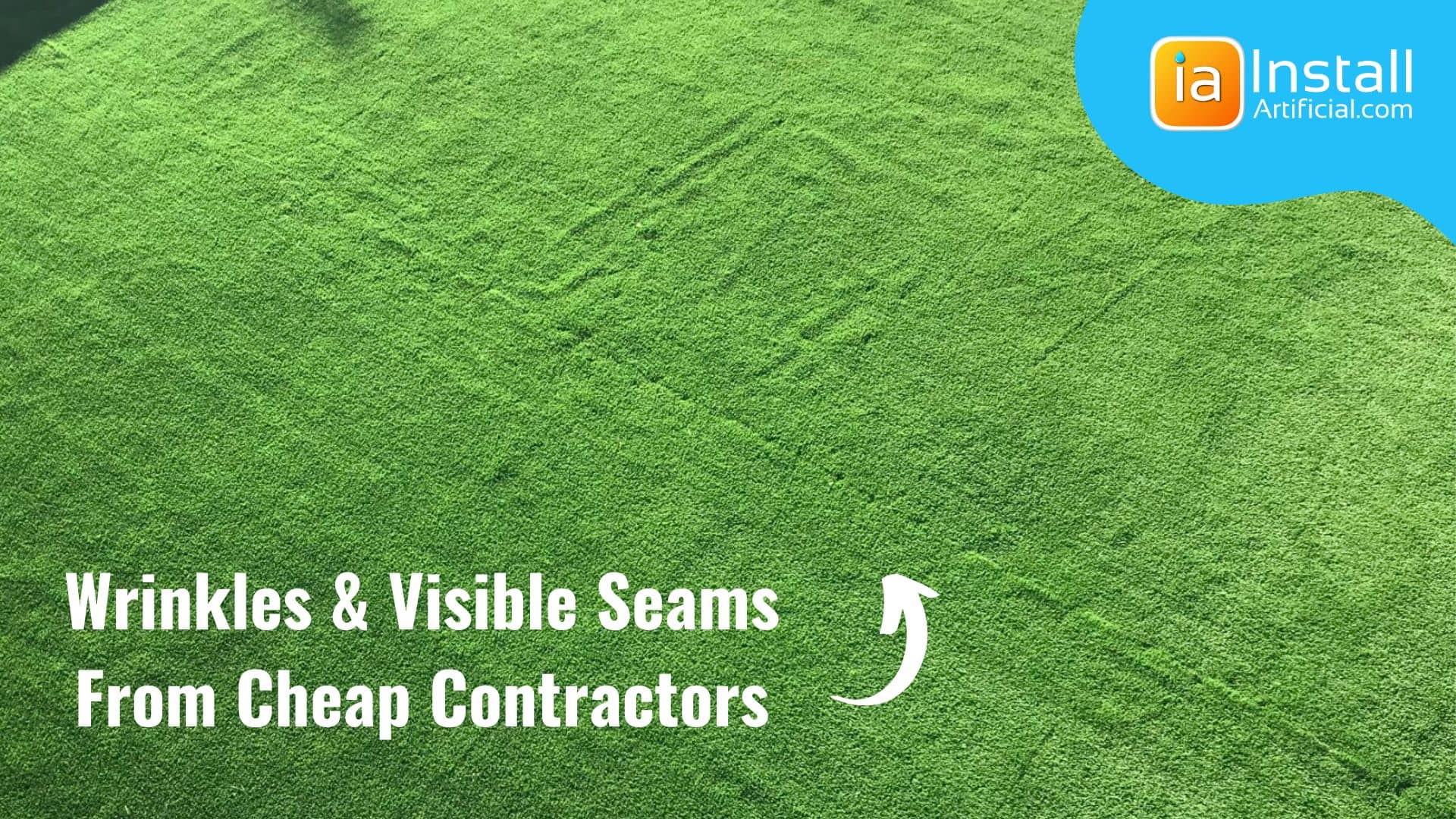
Untrustworthy turf installers will skimp on base prep and seaming, use cheap materials, and secure the installation in fewer areas to save them time and money. They then pass a bit of the saving to you and package it as a great promotional deal. This will cause wrinkles, turf uplifting, and dips to form over time. Spend the extra money now to install it right or run into costly repairs in the near future!
Artificial grass installation will typically require a hefty upfront investment. However, it's important to remember that you'll save on mowing, upkeep, and water usage over time. Adding this with a boost in property value and often these installations pay themselves off within a few years.
Because artificial grass is made of synthetic fibers, it can become hot to the touch when directly under the sun on high-temperature days. While this isn't hot enough to burn the skin, it can become uncomfortable to use or play on in these conditions. For the best cooling results, opt for premium infills and choose an artificial grass that's less dense.
The Achilles heel of artificial grass is magnification. This occurs when the sun bounces off a window or stainless steel appliance and ends up reflecting onto the surface of artificial grass. This won't catch fire but can cause the turf in that area to begin to melt in extreme temperatures. If you often see white sun reflection lines in the area, you may be at risk of magnification occurring and we'd recommend consulting with a professional before moving forward with installation.
Dogs love artificial grass! It offers a clean and pest-free surface for them to play on. You will no longer worry about them tracking dirt into the house or digging holes in your lawn. However, when dogs use artificial grass to go to the bathroom you must consistently rinse and sanitize the surface, or bacteria will get trapped beneath the surface and cause odor to occur. When this is ignored for too long it will become irreversible and the only fix is a new installation. For the best results, opt for pet-friendly packages and infills to assist with longevity.
Most homeowners install artificial grass because they have dirt patches in their backyards. When winter comes, this dust becomes mud making their space unusable. Having an artificial turf surface allows you to convert empty backyards into livable spaces. This is the number one reason we hear from homeowners requesting a quote.
As water becomes an increasingly scarce resource, it is more important than ever to find ways to conserve it. One simple way to do this is by installing artificial grass in your yard. Artificial grass requires no watering to stay green and lush year-round. In drought-prone California, cutting back on water use is crucial to prevent future shortages. By making small changes like this in our daily lives, we can help preserve this vital resource.
Maintaining a natural grass lawn can be expensive and time-consuming. You have to water it regularly, mow, edge, and more just to hope it looks decent. Even if you don't hire a gardener, this often runs up your energy and water bills. By installing artificial turf, these costs are heavily reduced. Artificial turf requires much less watering than natural grass, and it doesn't need to be mowed. This is the number one reason for covering front lawns with artificial grass.
With new and improved technologies, synthetic grass has never looked more realistic! Choose from a selection of high-quality American-made grasses that will keep your lawn looking natural. With multi-colored fibers and non-directional blades, you no longer have to worry about a bright green cheap-looking lawn. Raise your property value by having a lush artificial lawn all year!
Most high-quality grasses will also feature technologies to resist fading or color change from sun exposure, as well as a luster guard to prevent any shine or reflection from occurring. To be sure, take your samples and compare them to natural lawns in your neighborhood to find the most realistic option!
Because artificial grass doesn't require sunlight or water to thrive, you can essentially install it anywhere! In shady areas, on rooftops and balconies, in between concrete slabs, and more! Synthetic turf can be used in conjunction with other hardscapes to create the perfect backyard design during landscape renovation. It can be cut to fit any curve or contour and because there are so many different options, you're sure to find the perfect fit for your intended use.
It's no secret that one of the most sought benefits of synthetic turf is how clean it stays. Whether you have children or pets, no longer will you have to worry about them tracking mud or dirt into the house after playing outside. Also, because the ground is prepped prior to installation, most bugs and pests will have to search for a food source elsewhere. Suffer from seasonal allergies? Removing natural grass from your lawn removes allergens as well.
Sinteic grass and artificial grass are the same thing. You'll find that the words synthetic and artificial are used interchangeably within the industry. This is completely up to turf suppliers and their preferences, however you rest assured that they're the same product! Both are surfaces made of synthetic fibers to mimic the look of natural grass.
In Southern California, artificial turf installation costs will typically start at around $9-$12/sq. ft. depending on the scope of your project. Factors affecting pricing include accessibility, project size, location, edging and irrigation needs, quality of material, and more.
The type of installation will also result in variances in pricing. For example, installing turf over concrete requires less labor than installation over soil so often these installations are more affordable.
Let's dive into the world of grass, starting with real grass. Real grass is the product of carefully planting grass seeds or laying down sod, which is essentially a roll of grass and soil held together by netting or cut grassroots. This natural beauty grows and flourishes into a lush lawn.
On the other hand, we have artificial grass, a remarkable creation that mimics the appearance of real grass. Often referred to as fake grass, plastic grass, astroturf, or simply turf, artificial grass is made up of synthetic grass blades that are designed to look like the real thing. These various names all point to the same product: artificial grass.
Both types of real grass and artificial grass have their differences, the differences include:
How to Maintain a Real Grass lawn
Neglecting your lawn can lead to costly consequences, making it essential to prioritize its maintenance. By consistently caring for your lawn or considering the switch to artificial grass, you can prevent unnecessary expenses.
How to Maintain an Artificial Grass lawn
Maintaining artificial grass is a breeze and won't eat up your precious time. Instead of just mowing, take pleasure in your lush green lawn.
Exploring the aesthetic distinctions between artificial grass and a natural grass lawn
Real Grass
Real grass may not appear as flawless as artificial grass due to its dependence on external factors such as the season, which affects its color, texture, and blade height.
Artificial Grass
Artificial grass is the ultimate solution for those who desire a flawless and immaculate front lawn all year long. With its consistent height and color throughout the seasons, it ensures a picture-perfect appearance that is always ready for a photo. Many homeowners choose artificial grass to achieve the perfection they desire for their outdoor spaces.
Real Grass and Artificial Grass not only have contrasting maintenance needs, but they also diverge significantly in terms of their initial expenses.
Real Grass
The cost of sod rolls for a real grass lawn ranges from 35 cents to 99 cents per square foot, with additional installation costs of $1-2 per square foot. To safely budget for a new lawn installation, it is recommended to allocate $2.5 per square foot.
In addition to the initial costs, there are ongoing expenses for maintaining a real grass lawn, such as mowing, fertilizing, and watering. Watering your natural grass can result in a substantial increase in your water bill, and mowing will require 30 minutes of your time every week.
Artificial Grass
The initial cost of installing artificial grass may be higher compared to real grass, but the long-term savings on maintenance make it a worthwhile investment. Typically, professional turf installation starts between $9-$12 per square foot. With artificial grass, you can say goodbye to water bills and the need for a lawn mower, while also reducing the time and effort required for upkeep.
In contrast, real grass comes with ongoing maintenance costs that can quickly add up, making it a less cost-effective option in the long run. While the initial cost of artificial grass may be higher, the savings on maintenance make it a more affordable choice over time.
Real Grass
According to Clean Air Yard Care, real grass requires the use of gas lawn mowers, which unfortunately emit dangerous pollutants into the air. This means that maintaining a natural grass lawn can contribute significantly to air and noise pollution. In fact, studies have shown that gas lawn mowers can be up to 40 times more detrimental to the environment compared to running your car for the same amount of time.
Artificial Grass
Artificial Grass offers a multitude of benefits, including the fact that it requires no mowing, making it an environmentally-friendly choice. Not only does installing artificial grass help reduce water usage in drought conscious states, but artificial turf provides a dirt free clean space for your family.
Artificial grass is usually made of 3 different fibers. Sometimes, synthetic grass will be made of a mixture of these yarn types for added durability. It's important to understand the differences that these fibers offer to make the best choice for your intended use. Keep reading below to learn more!
Most often, artificial grass is made of polyethylene. With its soft feel and various textures, polyethylene turf is able to mimic natural grass more so than the other material options. Also, because polyethylene itself is non-porous, it doesn't retain odor making it the ideal choice for pet-friendly lawns.
Polypropylene is also often used to make artificial grass. This is the most affordable material option, but also the least wear-and-tear resistant. With a very fine texture, polypropylene will not hold up to consistent use or play over time. Turf products made of this yarn are ideal in areas where there's little to no foot traffic; such as decorative lawns, walls, or indoors.
This is the strongest artificial grass fiber available on the market. Synthetic turf made of nylon is known for standing up to heavy foot traffic and high temps without losing its shape or matting. Ideal in commercial settings, nylon offers a durable blade but it comes at a higher price.
Because of its high costs and stiff feel, often homeowners opt out of nylon grasses for backyards or landscape applications. Nylon artificial grass is most common in areas where magnification may occur, high traffic commercial spaces, or for artificial putting greens.
Landscape artificial grass is used in residential and commercial lawns, and its overall intended use is to just provide a cleaner and green space with fewer maintenance requirements. Most artificial grass on the market fits into this category, giving homeowners a lot of options to choose from.
Because turf can be cut to fit any landscape, you're free to design the backyard of your dreams! Whether you want tall and plush synthetic grass that's barefoot friendly or shorter grass with a durable blade to withstand the elements over time, you're sure to find the perfect fit for your needs.
Most permeable artificial grasses can be paired with a pet turf system. However, tall and plush artificial grass is not recommended in pet-specific areas because they are harder to clean and upkeep. Ideally, the best turf material for dogs is something durable that's shorter and less dense for advanced drainage and easy cleaning.
Most suppliers will have a couple of pet turf options in their catalog, the only downfall is these grasses tend to look less natural than landscape artificial grass. Turf that's specific to pets is most necessary for areas where multiple dogs will be consistently present, such as dog parks or doggie daycares. Typically homeowners will pick a landscape turf that's both natural looking and durable to pair with a pet turf system for their backyards.
Regardless of the grass you choose, without pet-friendly add-ons and consistent sanitizing, an artificial lawn will begin to smell over time from pet use. Reference the add-ons section to learn more about pet systems, and the maintenance section to learn more about pet turf cleaning best practices!
Because synthetic grass can be used pretty much anywhere, its becoming more common in unconventional spaces such as rooftops and balconies. Turn your drab concrete into a cozy hangout space! For these types of installations, you'll want to find something soft and plush to provide a barefoot-friendly feel. Because rooftops and balconies tend to see less foot traffic, you can opt for taller and denser grasses without the worry of premature matting.
For balcony and rooftop turf, manufacturers recommend also opting for a drainage layer to help accelerate drainage and ensure water does not get trapped beneath the surface because this can cause mold to occur. This is especially necessary for areas with a lot of rainfall or moisture in the air.
Sports turf has long been common on athletic fields, but has also become a great flooring alternative in gyms and health facilities as well! The cushion that artificial sports turf provides can offer additional shock absorption which can help protect your joints during high-impact workouts. Whether you're doing Crossfit, sled exercises, weightlifting, or playing on a sports field, synthetic sports turf can offer a cushioned and clean surface year-round with reduced maintenance needs.
There are many different types of sports turf, with varying pile heights depending on your intended use. For fields, you'll find sports turf will have a higher pile height to mimic natural grass. You'll find short sports turf in gyms and areas with heavy equipment for easier movement along the surface. Regardless of use, sports turf should be very durable to resist wear and tear.
When shopping for sports turf, you'll find that there are even options that come with built-in padding! This is ideal for extra shock absorption and cushion. There are also many turf underlayment pads available to use in conjunction with unpadded sports turf. Start shopping for gym turf now!
Turf for putting greens all appear fairly similar to directly reflect the look of natural putting greens and provide an optimal ball roll. With varying color shades, this type of artificial grass features a very low pile height, typically between 0.25-0.75", made of dense and curled fibers. Artificial grass allows homeowners to practice their putts anywhere, both indoors and outdoors. As an added bonus, with artificial putting greens you no longer have to worry about consistent upkeep or a bad swing damaging your green.
When designing a putting green, material choice is up to personal preference and desired stimp speed. You can also play with infill levels to adjust the stimp speed! Because putting green installation requires more leveling, grading, and labor to not negatively affect gameplay, we don't recommend DIYing this type of project.
Artificial grass for playgrounds is another type of artificial grass category. This grass features durable and traffic-resistant blades while also remaining dense enough to provide shock absorption for children as they run around. This type of artificial turf must perform well in multiple categories such as recovery rate, cushioning, and wear-and-tear resistance to hold up to consistent play. Because kids are more likely to lay and roll around on the grass, you'll also want to opt for playground turf that remains cooler on hot days.
For commercial playgrounds with heavy equipment, playground turf will often require a layer of padding underneath to meet ASTM fall standards. There are also more affordable padding options for backyard play areas! Check out the material add-ons section to learn more.
Artificial grass lawns can last anywhere from 8-15 years depending on the quality of materials, installation practices, and overall upkeep of the grass. The more you take care of the lawn, the longer it will appear freshly installed. It's recommended to brush your artificial lawn with a stiff-bristled brush every once in a while to redistribute the infill and bring the blades back to their upright position. Pet turf will require more consistent rinsing and sanitizing to prevent odor and bacteria growth.
The best way to lengthen the life of your synthetic lawn is to make sure you're purchasing the right turf for your intended use. For example, buying tall and plush synthetic turf for an area where multiple dogs will be at play will cause difficulty keeping it clean, a slower drainage rate, premature matting, and more.
While artificial grass is known for being very durable and long-lasting, there are a few things that can compromise or damage your installation. Avoid the following situations to prevent costly turf repairs:
Make sure you do research on the manufacturer the turf material is coming from because some offer better warranties than others. Typically artificial grass suppliers will offer a warranty that lasts between 8-15 years, and it's important to know what is covered in the event that damage occurs. Often, suppliers will cover damages related to product defects and premature fading but not damages that occur from the user or the elements. These synthetic turf warranties also rarely payout in the form of cash, offering store credit or just replacing the material for the damaged section.
There are multiple blade shapes when it comes to astroturf, and the shape of the blade can tell you a lot about the texture and function of the grass. Some blade shapes will create soft and pliable turf while others will feel stiffer, but offer more protection against the elements. Determining the type of turf blade shape you're looking for can help you narrow down your options!
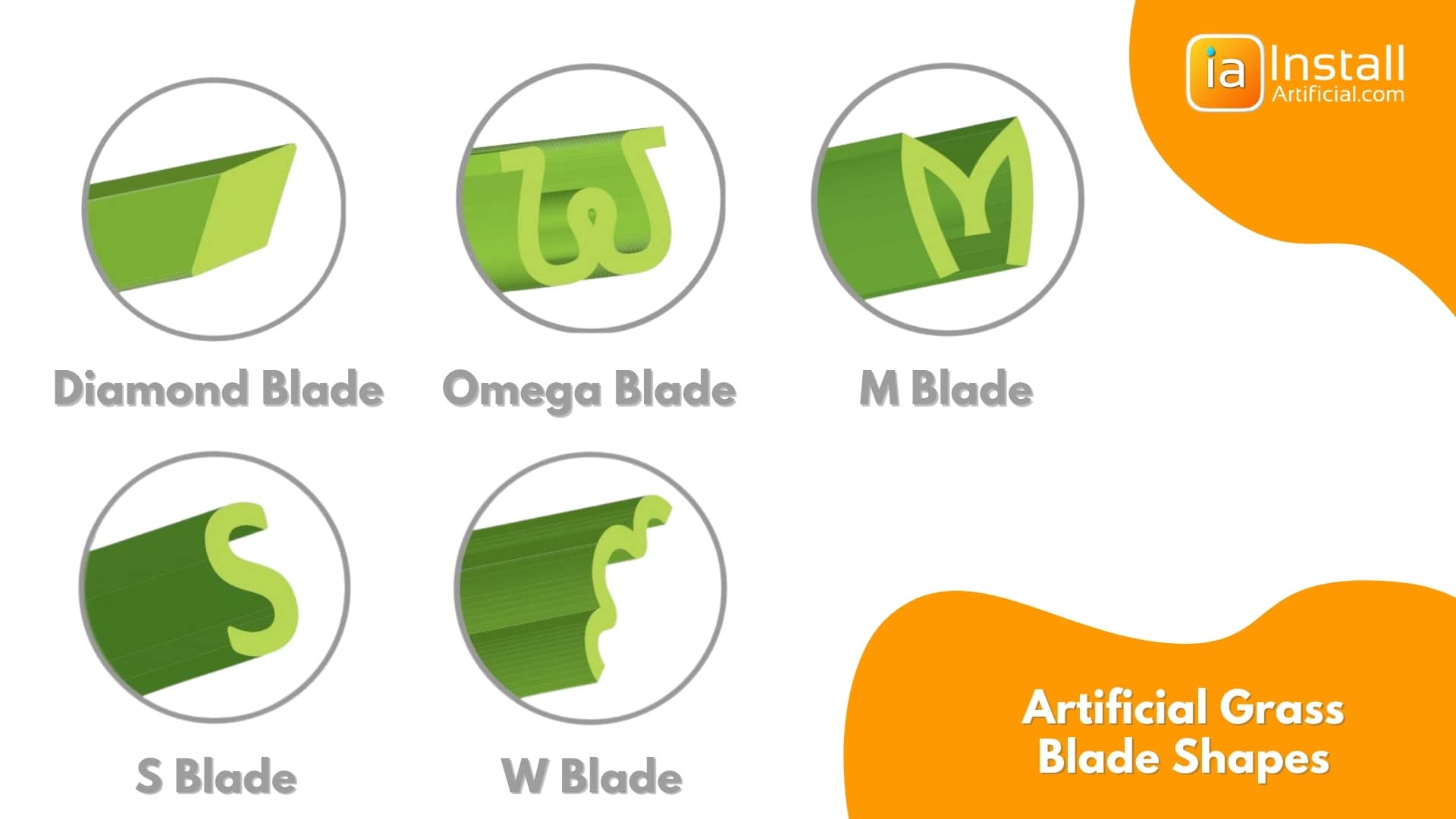
The S-shape of turf blades is advantageous because it more closely resembles natural grass than other blade shapes. The curves of the S reduce the amount of reflected sunlight, making the turf have less sheen and luster. S-blade turf is also softer to the touch thanks to these curved edges. This type of artificial grass occupies the middle ground in terms of resilience and is usually used in areas with moderate amounts of foot traffic.
The W-shaped turf blade is a new type of artificial turf that is becoming increasingly popular. These blades are designed to look and feel ultra-realistic, while also being durable enough to withstand heavy foot traffic and keep its original shape. The unique shape of the blade helps to disperse heat, by reflecting sunlight away from the surface. This can result in a cooler lawn in comparison to other types of artificial turf.
The omega-shaped blade is a more complex blade option. Resembling the ancient Greek letter, this type of synthetic turf is actually very strong and durable and is often used for high-resilience or short applications, such as pet turf.
M-shaped turf blades are also extremely durable, spreading pressure across several points on the blade. This prevents the blade from tearing under heavy foot traffic, making it ideal for landscapes and lawns that experience a lot of foot traffic, including sports fields and athletic facilities.
Artificial turf that is diamond-shaped creates a look that is similar to natural grass but with a softer, more luxurious feel. This type of turf is often best used in areas that receive low to medium foot traffic as it can better emphasize its aesthetic qualities.
Similar to the diamond-shaped blade, C blades will offer a pliable and soft feel. Typically featured in more affordable artificial grass options, C blades are ideal in decorative areas that receive little to no foot traffic.
Many homeowners and contractors will try to save money when applying infill and either completely skip this step, or opt for the cheapest option. However, infill is incredibly important to the integrity and lifespan of your artificial lawn. Infill provides stability, keeps the blades in an upright position, prevents the turf from wrinkling during temperature fluctuation, and even protects the backing of your synthetic lawn.
There are several synthetic turf infill options, with new alternatives popping up often. While most of these infills share the same intended objective, some perform much better than others. We'd recommend choosing the most premium infill you can afford to reduce the overall need for maintenance, brushing, and cleaning.
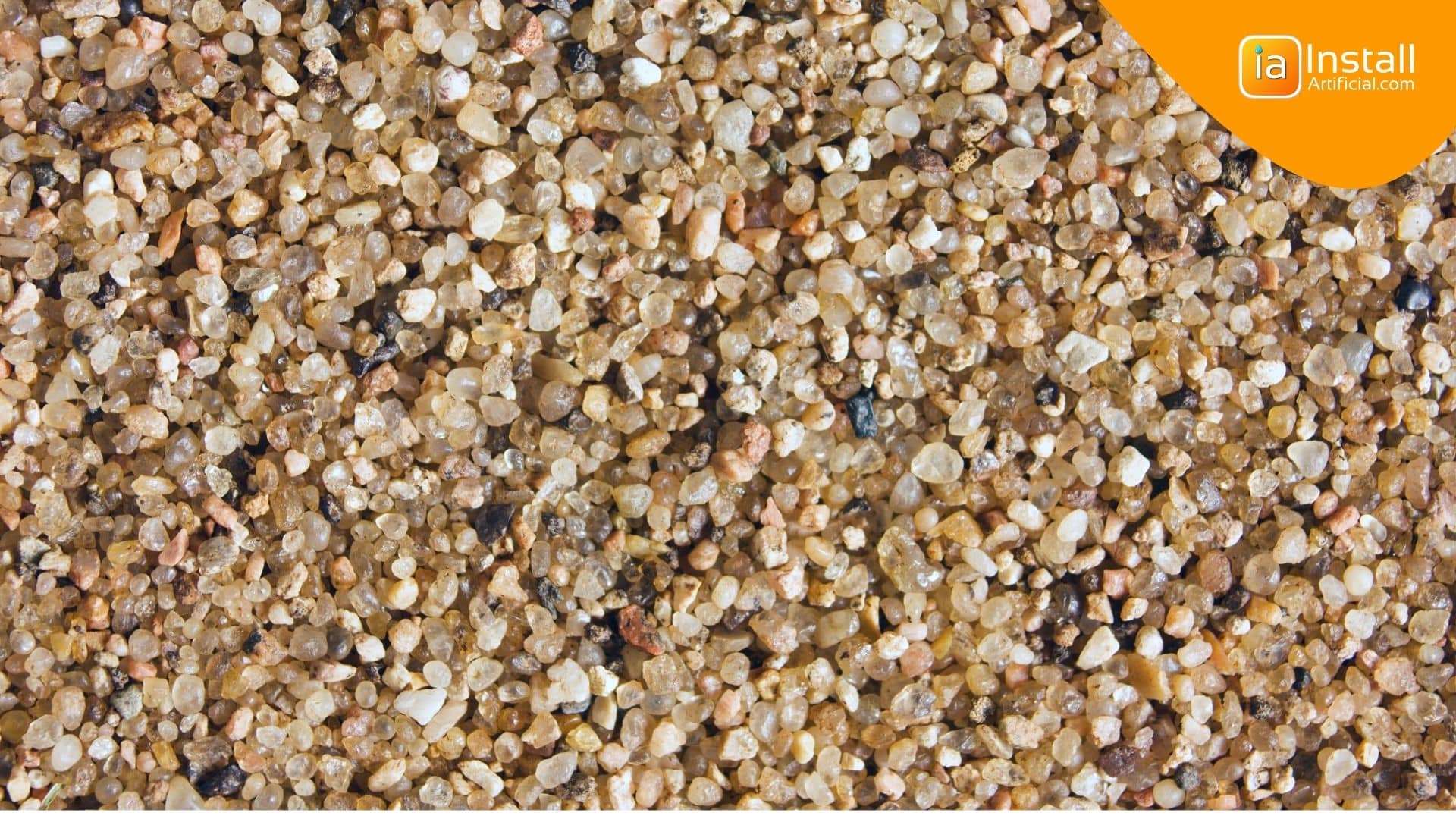
This type of infill is the most basic and affordable. Made of eroded and broken down quartz and rocks, silica sand infill is also the most commonly used infill. It helps support the blades of grass and also improves drainage. However, there are some disadvantages to using silica sand infill. Over time, the particles in the sand can harden and clump together, which decreases permeability. Silica sand can also trap pet odors, so if you have pets we'd recommend opting for a different and more premium infill.
Crumb rubber is made from recycled tires that have been ground up into small pieces. This type of infill provides a soft, bouncy feel that simulates natural grass making it ideal for sports fields. In addition, crumb rubber helps to add volume and fullness to artificial turf, while also helping to keep the blades of grass standing upright. Installing crumb rubber infill is also relatively easy and can be done quickly.
There are multiple disadvantages to using a crumb rubber infill. Rubber infill is known to create a black dust residue that can transfer onto clothing, furniture, and shoes. Crumb rubber also retains heat more so than the other infill options, making it much warmer to the touch under the sun. For these reasons, you will typically only see crumb rubber used in sports applications, where the function and bounce of natural grass is most important.
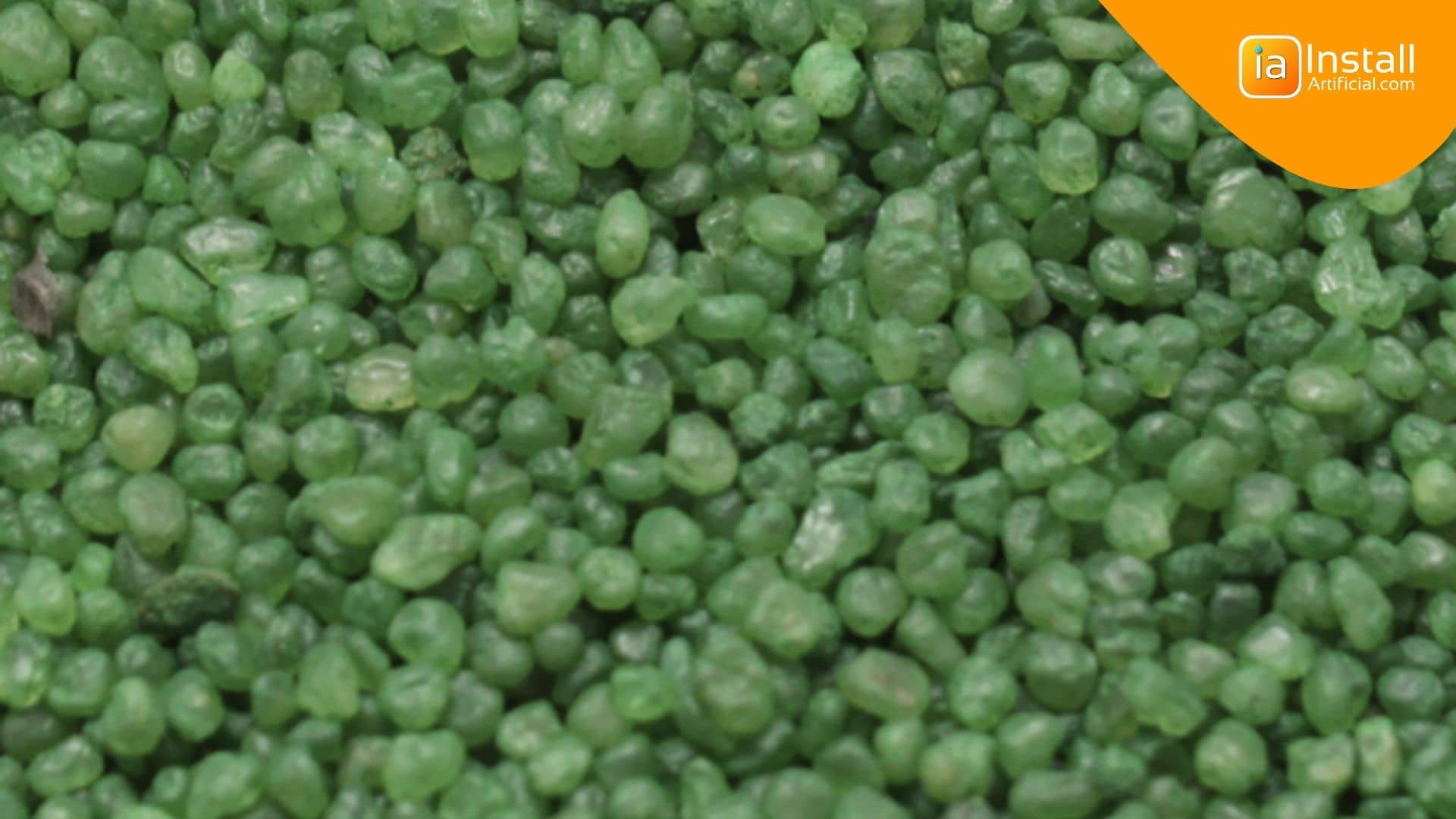
Antibacterial coated sand is a popular choice for homeowners with pets or children. It doesn't absorb heat from the sun like silica sand does, helping keep your lawn cooler. Additionally, its anti-microbial properties help prevent bacteria build-up from occurring. The granules are coated, making the sand rounded and less abrasive. Because it doesn't absorb liquids, it's the best option for pet turf installations. The only downfall to this infill option is that it has a higher price tag than both silica sand and rubber infill and tends to cover less space.
Cork infill is gaining popularity! It's a natural infill product that's made up of only ground cork. Because it offers similar gameplay as rubber infill without all the disadvantages, it's a good choice for sports applications. Cork is quick to bounce back and return to its original shape after providing shock absorption upon impact.
The disadvantage of cork infill is that it's still a fairly new alternative and can be harder to find. We've also seen that often this type of infill requires a bulk purchase, making it trickier to select for small residential projects if your contractor doesn't already have cork infill on hand. You'll typically find this infill featured in larger commercial projects or fields.
For those with pets, Zeofill is a great option. This all-natural and organic product acts as a turf deodorizer. Not only does it absorb urine and trap ammonia gases, but it also suppresses odors until they're washed away during cleaning or heavy rainfall. Zeofill can also retain more water than other turf infill options, keeping the surface of your artificial lawn cooler.
In our opinion, Zeofill should be used in conjunction with another infill. Zeofill is a very fine substance that can create a white film on top of your lawn. For this reason, when installing pet turf we typically will spread a layer of Zeofill underneath the turf to help with odors and use antibacterial sand on top.
People were looking for alternatives to crumb rubber and silica sand infill, so manufacturers began utilizing more natural materials. Granulated walnut shells are 100% organic matter and the selling point is that it's supposed to be a more effective cooling agent than either of those options. By absorbing water but not overexpanding, walnut shells can keep the surface of your lawn cooler, making it more comfortable to enjoy in hot weather.
As technologies advance, leading companies in the turf industry are working to advance their products with it. HydroChill is made with a special coating that is activated by adding water. This allows it to store water and release it through evaporation, providing a cooling effect on hot days. Designed to provide maximum benefit when the sun is directly overhead, HydroChill claims that it can lower the surface temperature of your lawn by up to 50 degrees in comparison to silica sand!
HydroChill is considered a premium artificial grass infill and will be priced higher than more affordable options. In our opinion, adding water to any infill will result in a similar cooling effect. This comparison is not sufficient in concluding that HydroChill offers lower temperatures.
Creating borders around your artificial grass is important to the stability of the installation. The turf must have a stable edge to use for support or the installation will basically fall apart over time. Synthetic turf will need a border to separate it from fencing, bushes, trees, and other landscapes. If there is a hardscape already bordering the edge of your artificial lawn, such as concrete or wood, installing more edging is not necessary.
The most popular and commonly used artificial turf barrier is a polymer bender board. This board is the most affordable edging product and is able to bend around the contours of your lawn easily. However, it's very tricky to use polymer bender boards in areas where the perimeter is a straight line. In this case, treated wood boards will have to be used as an alternative.
There is a polymer bender board substitute called Wonder Edge, we do not recommend this product. This edging is known for its convenient use but does not support the base layer and will fall apart quicker than other edging options.
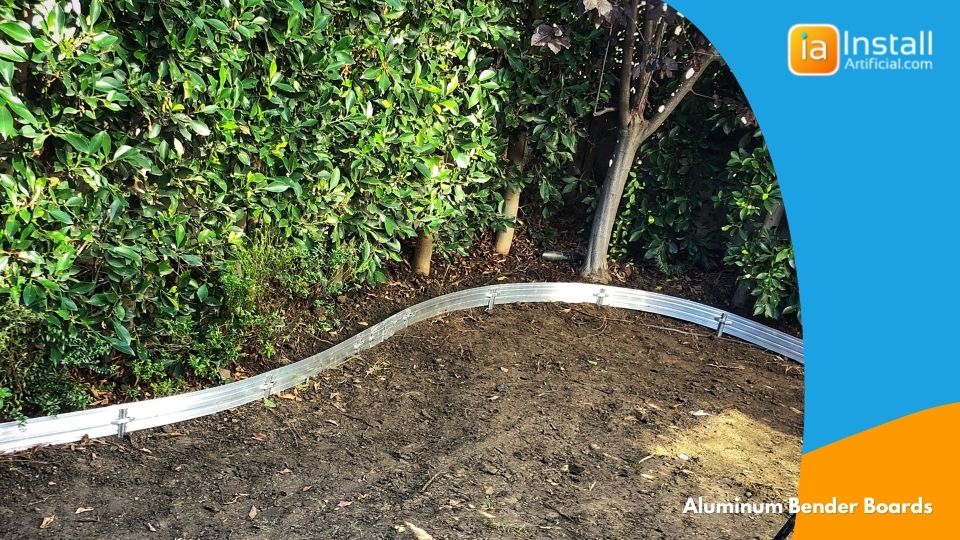
Aluminum bender boards are similar to polymer bender boards in that they are used in curved and contoured landscapes, but they are made much more durable. This type of edging is usually featured in parks, hotels, and other commercial settings. Aluminum bender boards are expensive and tricky to install but don't discolor over time as polymer bender boards do. We recommend aluminum bender boards to clients that are installing putting greens or turf on a slope, where additional stability is needed.
Treated wood boards are wood that's treated with chemicals to resist the elements, including temperature fluctuation and moisture. They do not expand with temperature change and offer a durable and straight edge that will last for years.
Treated wood boards can be visible or hidden depending on the client's preferences. To hide the treated wood border, you can simply stretch the turf over the wood and use heavy-duty staples to secure the grass to the edge. This will also eliminate the need for nails, which tends to be ideal for pets and children! Nail-free installations require more labor and edging around the entire perimeter, therefore will raise the overall cost of installation.
If you're doing a full lawn redesign, you can consider the edging during your renovation and create borders around your artificial lawn with concrete or a paver patio. Having a hardscape will usually eliminate the need for a barrier and create a seamless transition from grass to a walkway or patio. However, this is a much more expensive solution.
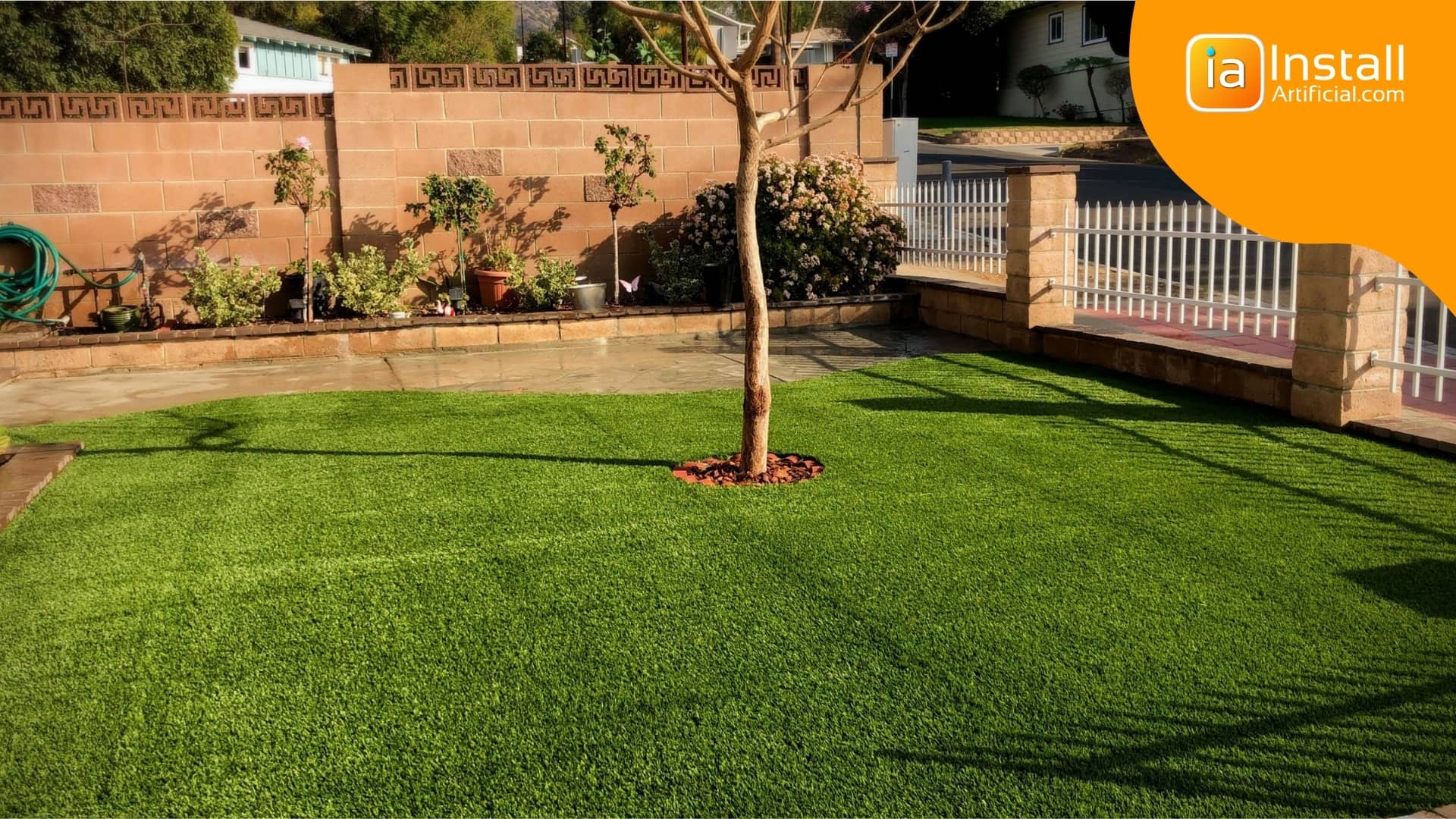
Trees within your lawn will need to have edging around them as well. We create these borders by using either polymer or aluminum bender boards to create a small ring around the tree itself. The ring is then typically filled in with mulch or pebbles to add a charming touch!
Don't forget, these trees need a water supply! Replacing natural grass around a tree with synthetic will remove its access to water. Smaller trees will require a bubbler and often rewiring of irrigation to remain alive. Large trees usually have much longer roots under the surface and can pull water from a neighboring lawn.
Gopher mesh is a rust-resistant wired panel that is laid over the base of the installation prior to laying artificial grass. This mesh helps protect your new synthetic lawn from pesky gophers and other rodents that attempt to dig through from underneath the surface. If you have a gopher problem, we would not recommend installing synthetic turf without gopher mesh. Over time they will cause seams to burst or edges to detach.
As mentioned above turf deodorizer, or Zeofill, traps and locks in odors from pet use and releases them when the lawn is flushed with water and sanitized. This helps prevent odor build-up in areas where pets use the bathroom. Make sure to consistently rinse and sanitize artificial grass for pets often to get the best results!
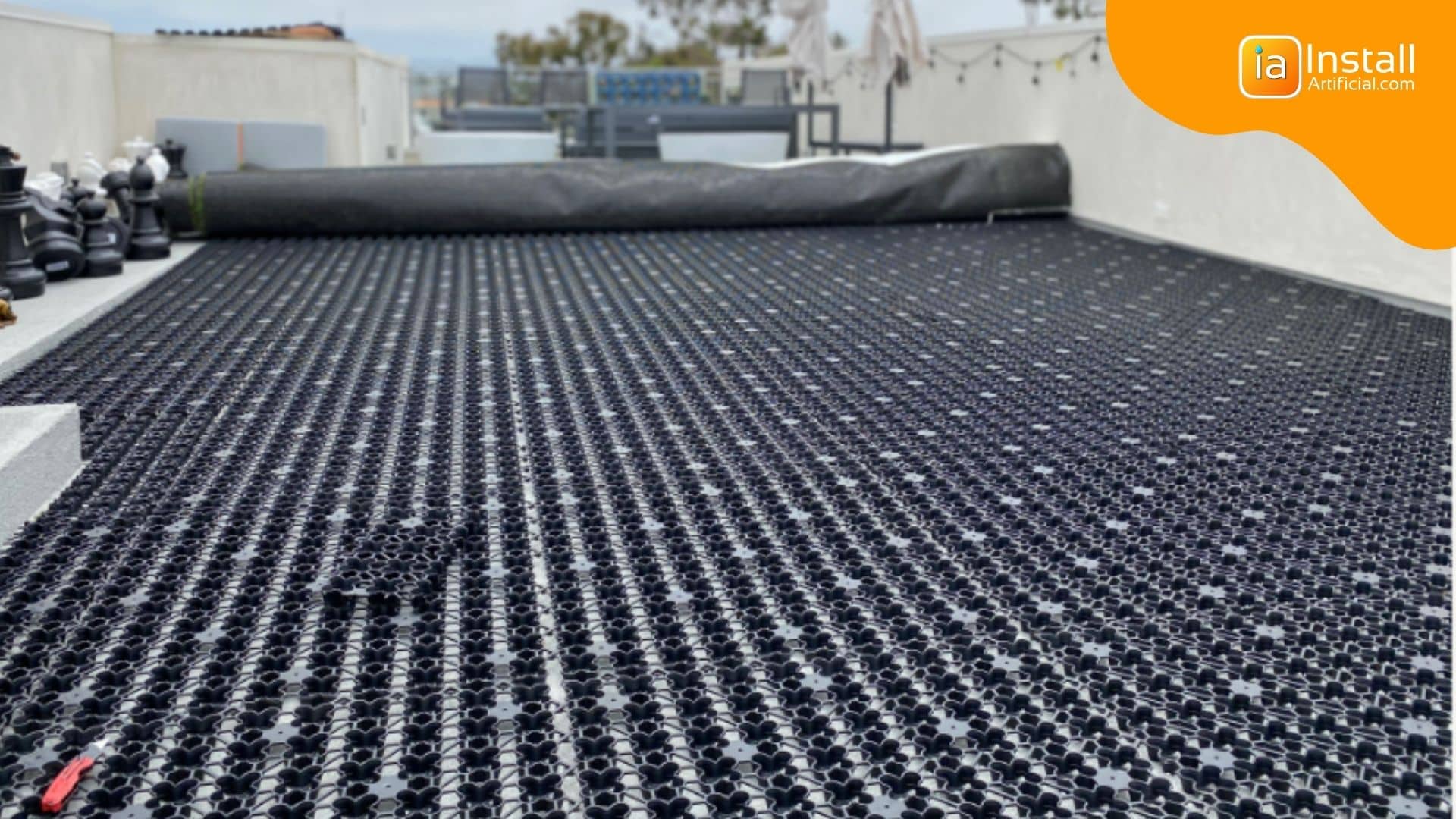
AirDrain and DrainCore are drainage layers used to help accelerate water movement underneath the surface. They're typically around an inch tall and create an air void between the grass and the sub-base to allow water to pass through. This is most necessary in pet turf systems, where urine and pet use will require the lawn to be consistently hosed down. Drainage layers are also recommended on balconies and rooftops, to prevent stagnant water and mold from occurring after rainfall.
To provide your artificial lawn with more shock absorption and cushion, you can also add a layer of padding underneath the artificial grass. Artificial grass padding layers can range from 5 mm thick to 50 mm thick. Often thicker pads are used for sports fields and playgrounds, where certain standards are required. The thinner 5 mm pads are ideal for backyard play areas.
Because these pads can slow drainage rates and hold bacteria, we do not recommend applying a layer of padding in areas where pets are present.
Bubblers help supply a tree or bush with water when it's surrounded by artificial grass. This bubbler is wired to existing irrigation to ensure the tree can remain healthy and continue to flourish.
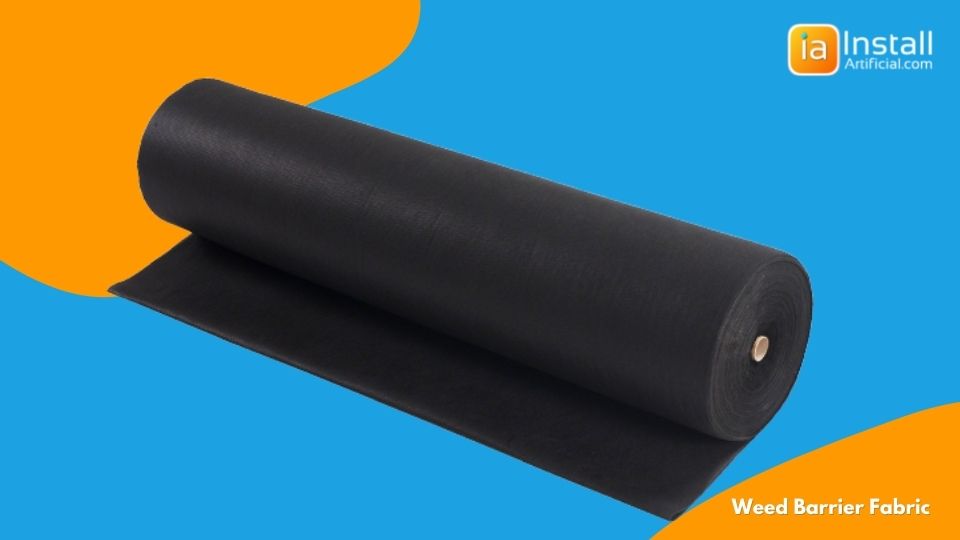
A common misconception is that weed barriers prevent weeds from growing, but this is not true. Weed barriers are large cloth-like fabric panels that prevent seeds from invasive weeds from penetrating the surface and entering the soil. This in turn can help reduce the probability of weeds occurring. In our opinion, this barrier is not effective enough to recommend. It's also known to lock in bacteria, so we never recommend weed barriers for lawns where pets or children will be present. Instead, we advise using a heavy layer of weed killer prior to base prep and compaction.
Even with a weed barrier, weeds can poke through the corners and edges. Although we don't endorse this product, we keep it as an optional add-on for clients that prioritize weed prevention.
Weed preventer is an herbicide. It's manufactured to kill and control over 40 different types of grass and weeds. After excavating 2-3 inches of soil from the surface, a weed preventer should be heavily applied. While this is optional, it's typically never skipped.
Artificial turf installation will block water and oxygen from getting under the surface. To prevent trees from dying, you'll want to provide oxygen to the roots. In order to do this, you drill 2-3 columns around the tree and reroute water to it. All that will be visible are flat caps that resemble a drain. With this add-on, the artificial grass can be installed all the way to the tree stem making your lawn look even more natural and removing the need for a board ring!
At InstallArtificial, our full pet turf systems consist of DrainCore, antibacterial sand infill, and turf deodorizer. This package helps prevent bacteria build-up, accelerates drainage, and controls odors from pet urine. In turf areas where pet relief is happening regularly, you'll be wasting your money if you don't opt for pet add-ons because the smell will begin to linger after just a few months.
It's also important to remember that while these pet-friendly materials assist with maintaining a clean lawn, you will still need to regularly rinse and sanitize the pet turf to get the best results. Once the odor and bacteria build-up has gone on too long, the smell will not be reversible and you will have to completely replace your artificial lawn.
This is the most common installation method, and what you'll most often see. Artificial turf installation over soil will replace the natural grass in a designated area. Using edging and irrigation products, you can install synthetic grass while still providing bushes, trees, and planters in the area with a water source.
When installing over soil, 2-3 in. of soil removal and base prep are vital to the stability of the installation. Cutting corners during the base prep can result in nails detaching, dips and bumps occurring, and ground movement.
Installing artificial grass over concrete driveways and patios has become more of a trend in recent years. This can extend your lawn space for more activity or simply provide a green and cozy area in comparison to hard concrete. When installing turf over a hard surface, manufacturers always recommend laying a drainage panel to allow for quicker water movement underneath the surface.
You can use transition tape or professional adhesive to secure the artificial grass to the surface, but keep in mind these may stain the surface upon removal. For this reason, we usually recommend only gluing on the perimeter or spot gluing underneath the surface to reduce the amount of adhesive used. For larger and enclosed areas, the turf itself may be heavy enough to stay weighed down without the need to secure it down. Because this type of installation requires less base prep, they are typically a bit cheaper than turf installation over soil.
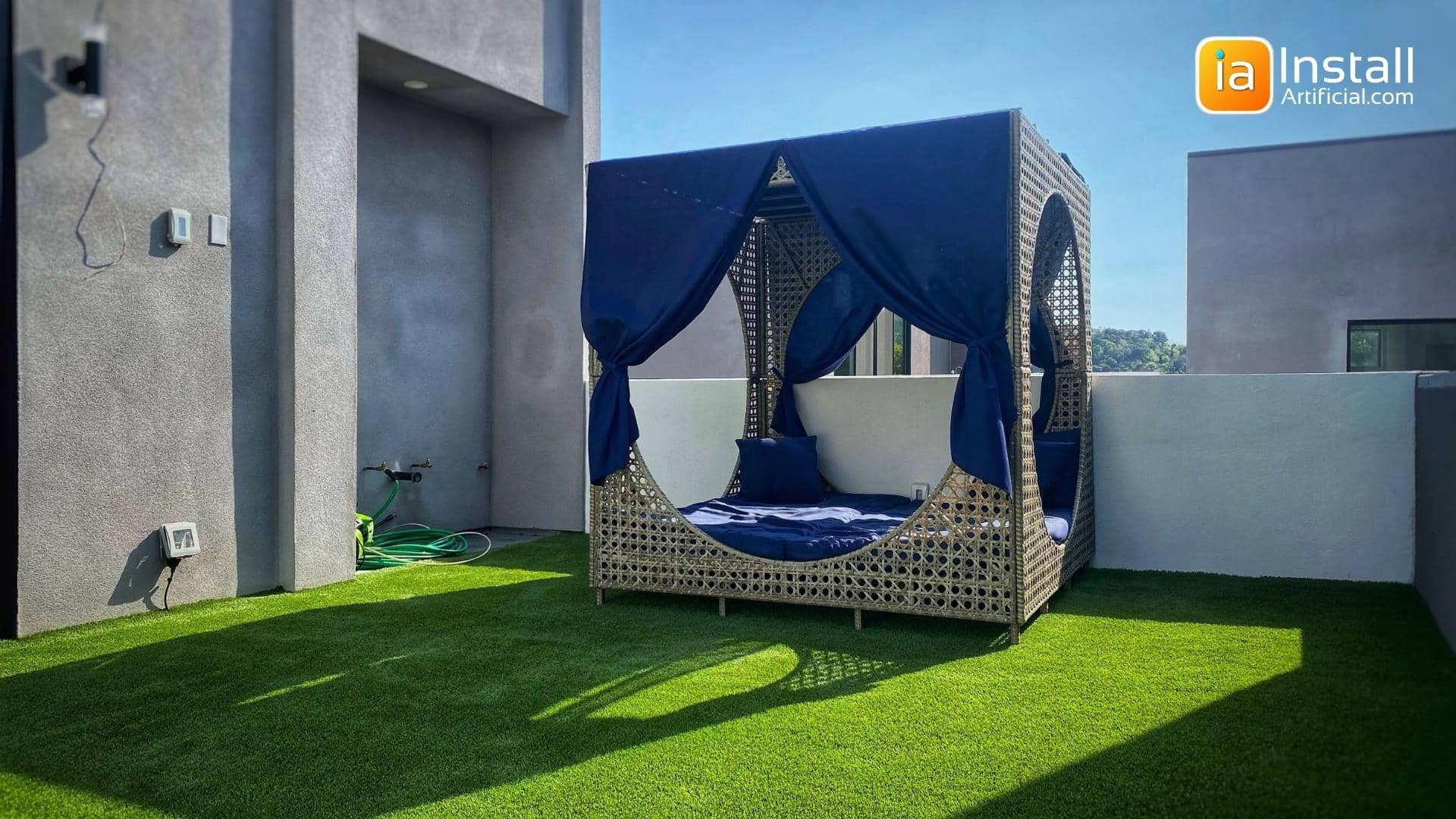
Artificial grass on a balcony or rooftop provides a barefoot-friendly outdoor space that becomes instantly more inviting after installation. The ease of application and cleaning makes it ideal for those looking to quickly transform their area. You can even vacuum it! Turf installation on balconies and rooftops offers the simplest installation. Often you can simply cut your materials to size and lay them down. This makes this type of installation easy for those who want to DIY!
Turf Installation methods for balconies are very similar to those over concrete. When installing artificial grass on a balcony or rooftop it's always recommended to use a layer of drainage underneath the surface to help rainfall and other moisture leave the area quickly. This is especially important on rooftops because stagnant water can cause roof damage over time. Water pooling on and underneath the surface can also attract bugs and allow mold or mildew to grow.
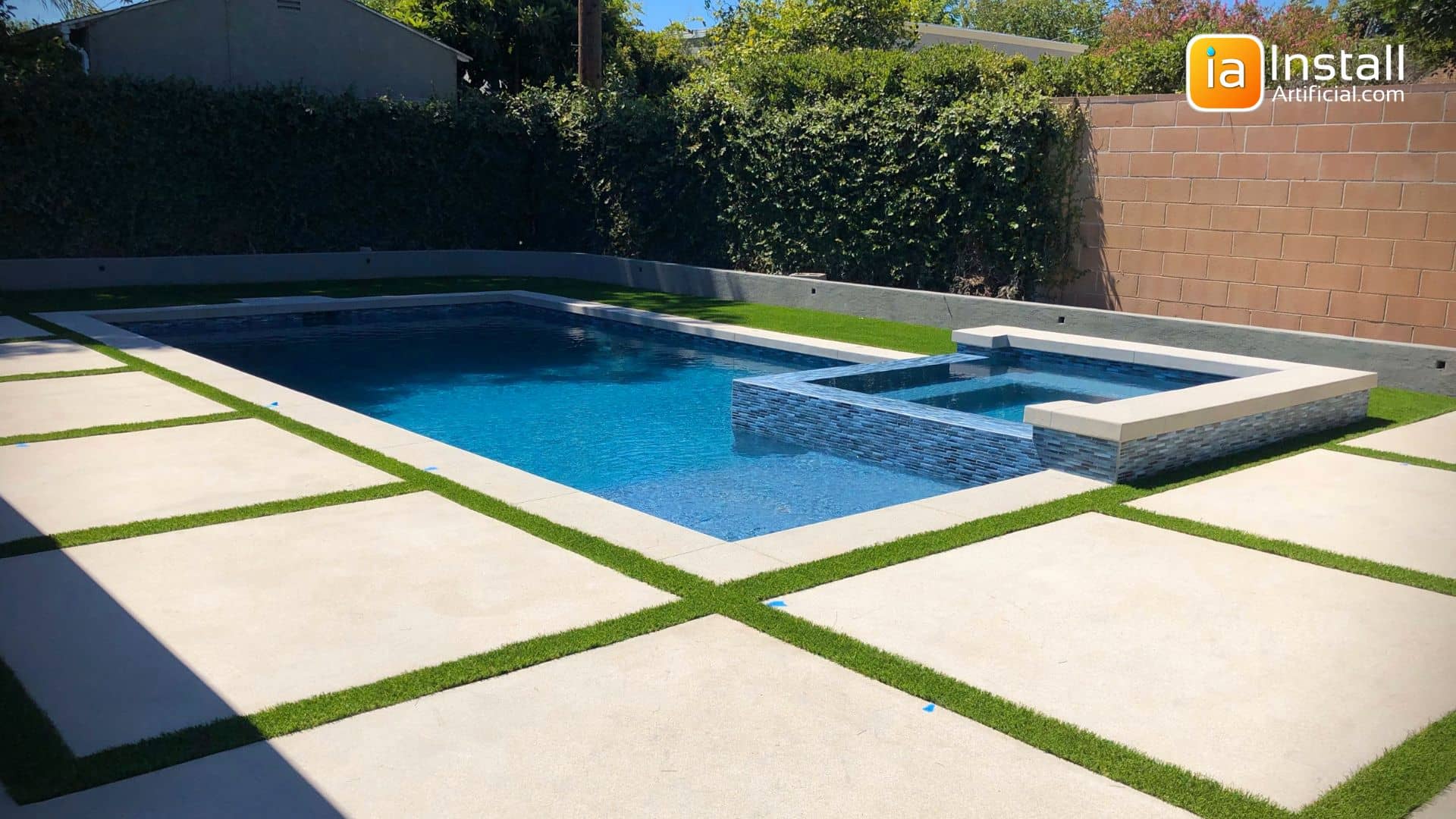
Artificial turf Installation between concrete slabs, stepping stones, and pavers really elevates the look of your lawn or driveway. Because artificial grass can be cut to fit any shape, homeowners are becoming more creative with how they implement it into their landscapes. When laying synthetic grass between concrete, you can have it flush with the ground or have a fluffy overspill depending on personal preference.
Pricing for turf between concrete will typically be charged per linear foot at a higher rate because installing artificial grass in narrow spaces is a more laborious process. This installation method requires manual compaction and more cutting, seaming, and securing.
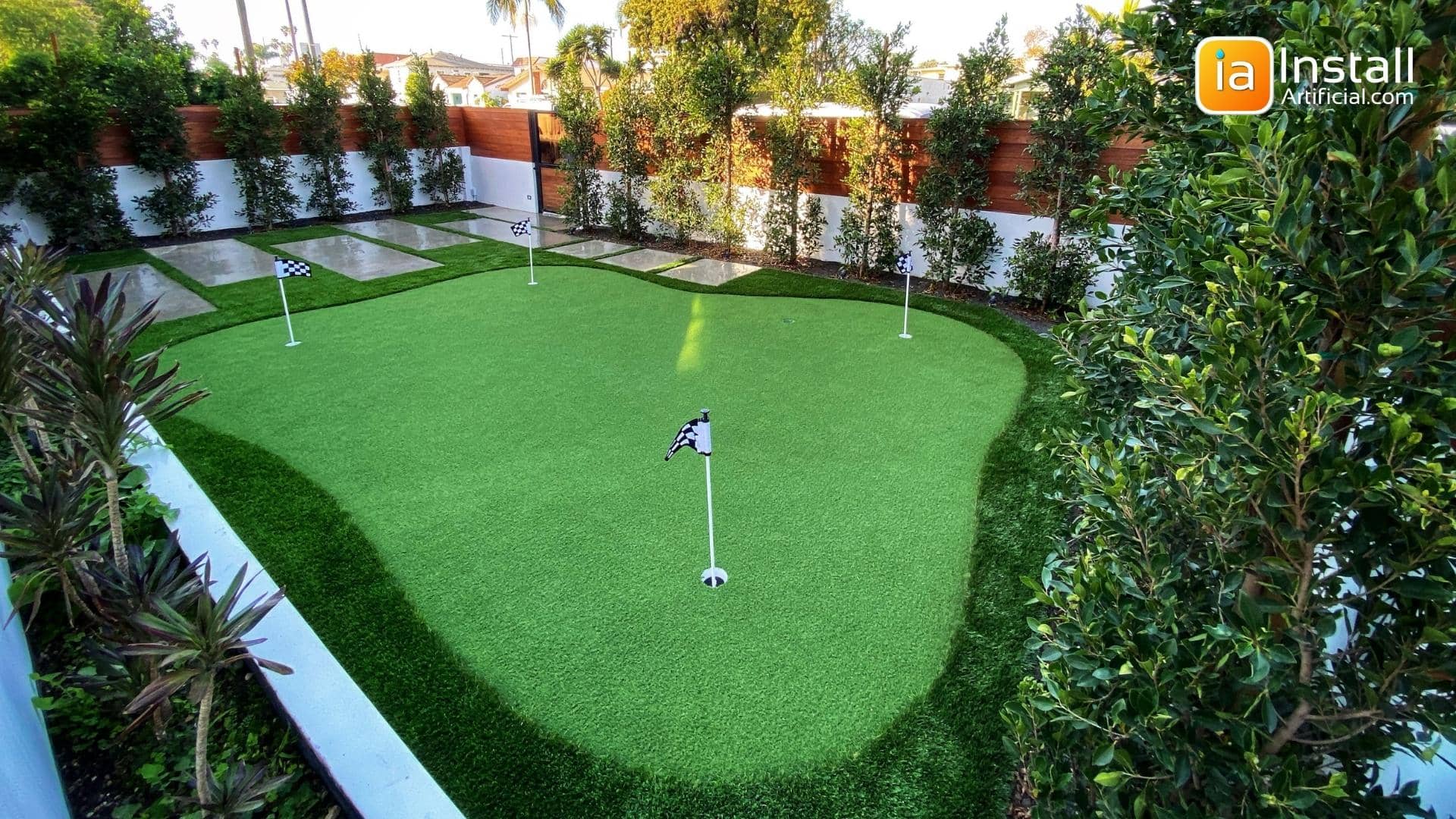
Backyard putting greens offer you the freedom to practice your putt at any time from the comfort of your own home. You can design and create any shape or contour with as many holes and obstacles as you desire to challenge yourself more. It's completely customizable! Paired with a higher pile grass for the fringe, we're able to directly replicate the look and feel of a natural green.
These installations require more skill and expertise because there are multiple contoured cuts to make and grading/leveling is very important. Creating an uneven or bumpy surface will negatively impact gameplay and can cause the ball to roll on its own. Also, putting green turf is much shorter and denser making imperfections along the surface much more visible.
Typically the base for artificial putting greens is 1-2 in. thicker than a regular install. installers will add a fine layer of decomposed granite on top of the road base to help smooth the surface. The cups for the holes will be fixed into the base layer using concrete.
An average artificial grass project will take anywhere from 1-5 days depending on accessibility and overall scope of work. Below we'll walk you through the installation process for a typical artificial grass installation over soil. Be sure to check out our knowledge base for guidance on how to install artificial grass over other surfaces!
One of the most crucial aspects of this process is the preparation of the sub-base, which must be clean and ready for use before installation can commence. This typically involves rough grading the land, as well as removing any irrigation, existing pipes, or electric wires that may be present. Once the area is excavated 2-3 in. apply a heavy layer of weed preventer. Bender boards are also installed to separate the artificial grass area from other plants and grass.
Installing a smooth and stable base is the name of the game, and this base should be 2-3 inches deep. Use class II road base for the best results. For added smoothness and leveling, you can add a thin layer of decomposed granite on top.
Base preparation is a more costly part of the project and will cause the ground to move and settle over time if not installed correctly. Shady contractors can cut corners on this step and you would have no idea until the ground starts to show dips and bumps months later. For this reason, it's very important to supervise this step and ensure they're following manufacturer guidelines.
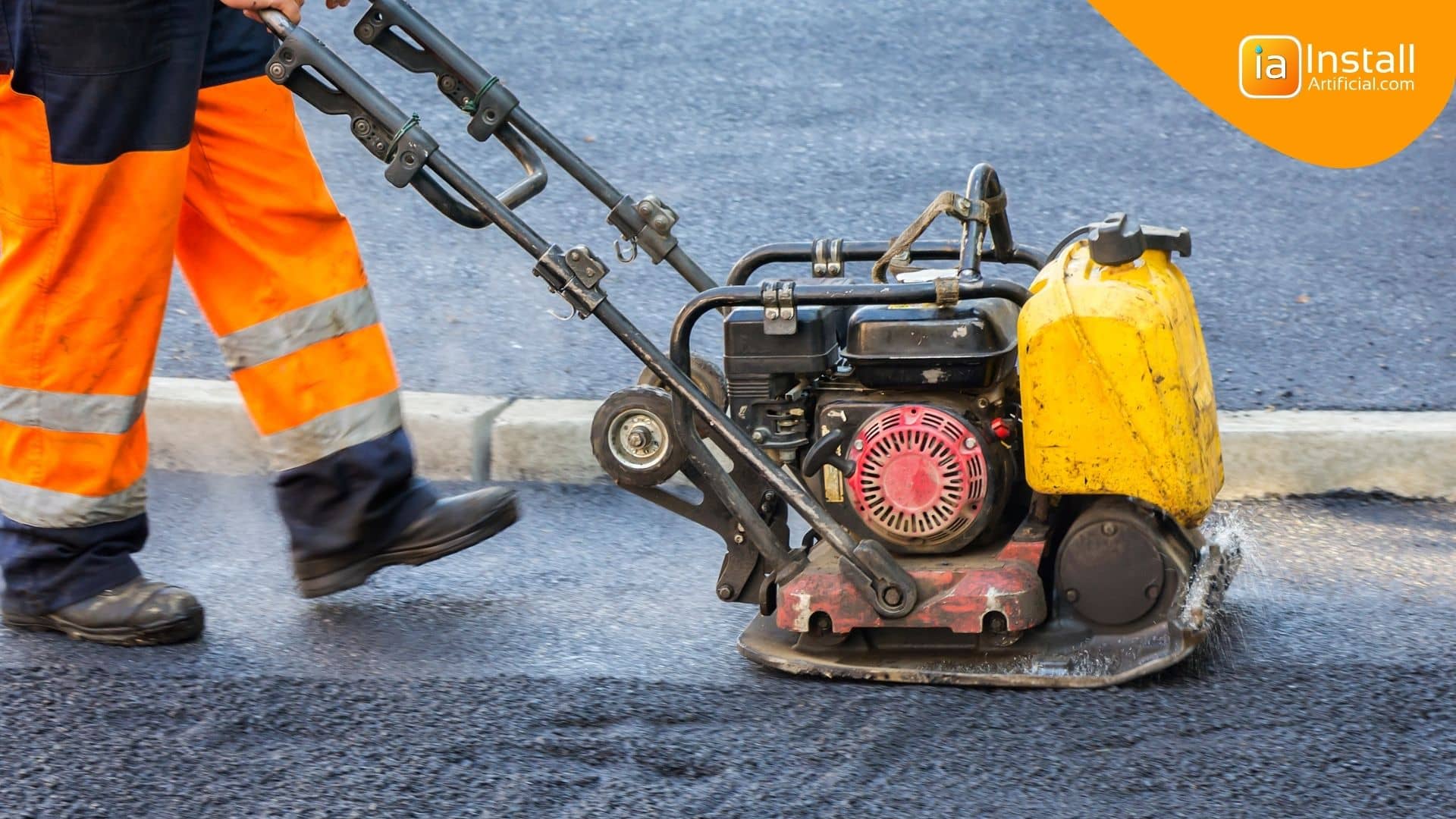
To ensure a level base for your turf, you'll need to vibrate and pack the road base with a heavy-duty roller or professional compactor. Double compaction is often recommended for playgrounds and pet areas, as it helps to prevent nails from loosening and coming up over time. Compacting the base correctly will strengthen the surface and also help to avoid any future issues with nail uplifting.
Before beginning to stretch and secure the artificial grass, let the turf roll lay out in the sun for about 30 minutes so it softens up and is easier to work with. Artificial grass is manufactured to naturally lean to one side. The most appealing view is generally looking at the grass against the blade fall. You'll also usually want to position and lay the artificial grass so that the blades are pointing towards the direction that brings the most foot traffic. When seaming multiple pieces together, it's imperative that the pieces are facing the same direction or the grass will look patchy.
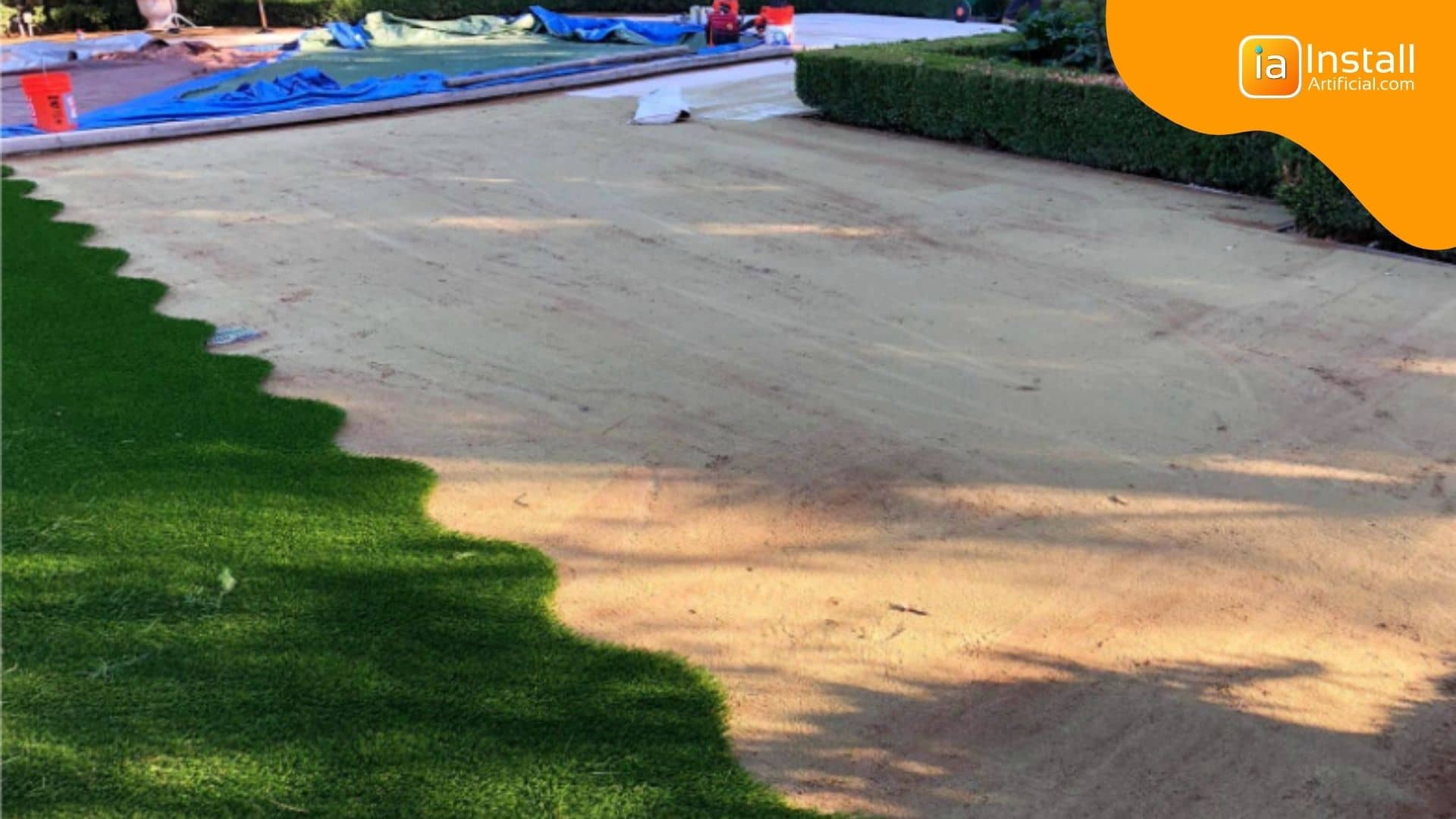
When cutting artificial grass to size, leave yourself about a foot over overlap to be safe, you can always come back and cut more off later. When seaming turf pieces together, do so in the shape of an "S" or a zipper to create an illusion to the eye that hides the seams. Seaming two pieces together in a straight line will result in a visible crease within the lawn.
Each turf installation will use thousands of non-galvanized nails. We recommend nailing into the surface every 2 in. around the perimeter and every 2 ft. throughout the entire area. Double-check that each nail is secure before moving on to prevent any nails from pulling up later down the line.
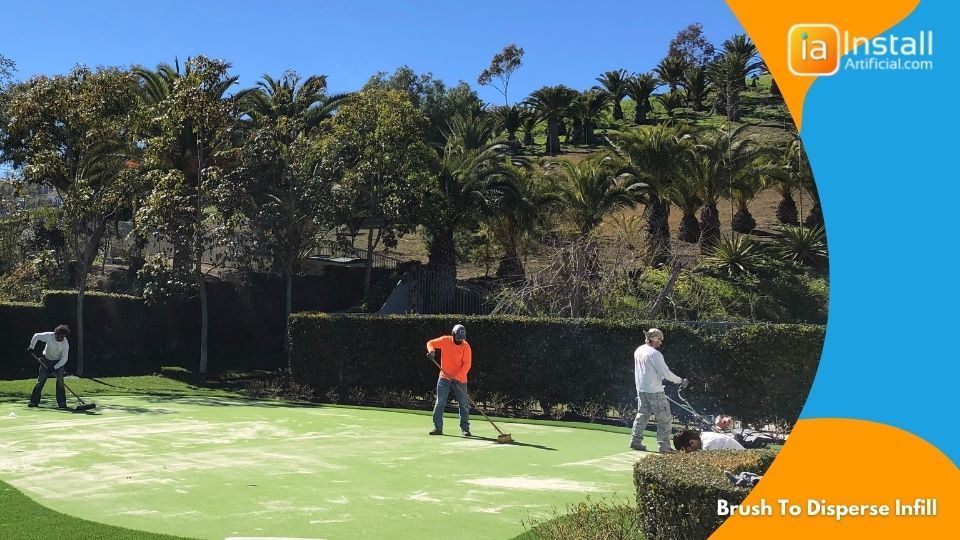
Applying infill is a necessary step so don't skip this process. Infill protects the backing, provides more stability and cushion, and gives the lawn a full and healthy appearance. Use a power broom to brush up the fibers so the infill can fall down closer to the backing. You'll then distribute infills evenly along the surface, applying about 1-2 pounds per sq. ft.
The final brush will remove any debris from the surface and help push the infill further down into the blades. Once this step is done you're free to enjoy your new synthetic lawn!
While the idea of maintaining an entire artificial lawn may seem like a daunting task, it's very quick and easy! Much more so than upkeeping a natural grass lawn. The ease of use is one of the most sought benefits of synthetic turf. However, artificial grass is not completely self-serving. There are a few small things you can do to lengthen the life of your installation and keep your artificial grass looking freshly installed for years.
Hose down the area once every couple of weeks to remove any debris and other residues from the surface. A garden hose will work perfectly. If you use a pressure washer, keep the nozzle away from the surface to prevent damaging the blade structure. Rinse the lawn evenly to keep the area looking uniform.
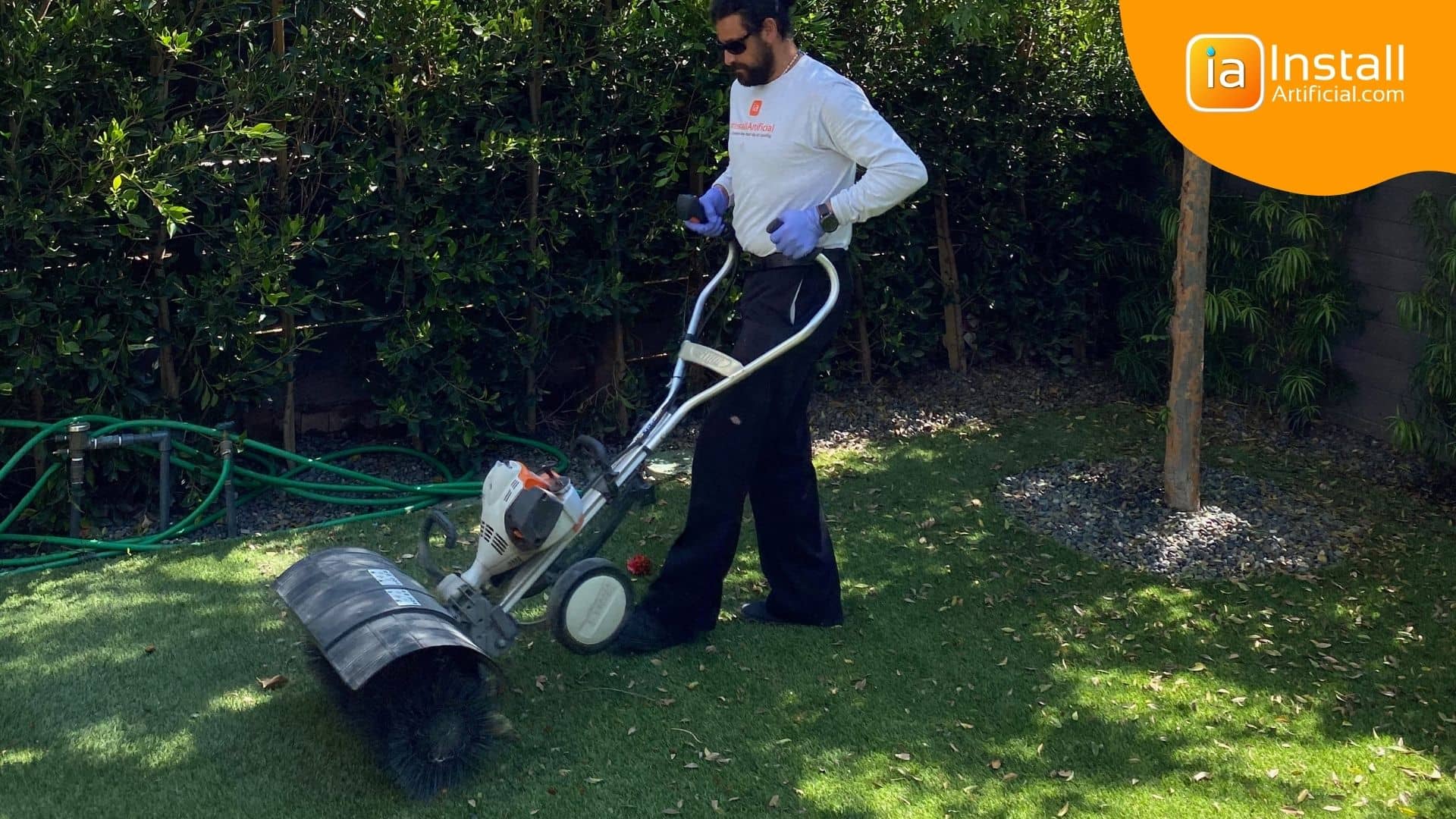
Use a rake or stiff bristled broom on occasion to brush through the turf and redistribute infills. This will also help fluff up the fibers and bring them back to their original upright position. You can also use a leaf blower to remove leaves and other debris. Excessive leaves on the surface can result in slower drainage rates.
Use non-toxic cleansers to clean and sanitize the area for pet turf or soiled areas. You can dilute the cleansers with water to better protect the turf's blades. We'd recommend using a high volume of water during the rinsing process to ensure all of the cleaning solutions are flushed from the grass. For slight pet odors, equal parts water and vinegar will typically do the trick! We also always recommend Wysiwash to pet owners. This cleanser simply attaches to your garden hose for easy use!
Pro Tip: Damp stains are easier to clean. Clean messes as they are made to avoid costly repairs and the need for professional cleanings!
If you need more assistance, you can schedule a professional artificial turf cleaning with InstallArtificial! We'll use our professional tools to brush, rinse, and sanitize your lawn to bring it back to life. But remember, once artificial grass is severely matted or has strong odors this can be irreversible. Taking care of your lawn is the best way to ensure that it will last for 10-15 years!
Artificial grass has come a long way since it was first invented in the 1960s. With so many different companies now offering their own unique products, it can be tough to know where to start when shopping for artificial grass. However, by considering your needs and doing your research, you can find the perfect artificial grass for your DIY installation project. Check out some of our professional tips below!
Before you buy artificial grass, make sure you've accurately measured your lawn space. Take measurements multiple times to be as accurate as possible. Purchasing the incorrect amount of artificial grass will cause installation mishaps. A common mistake made when buying synthetic turf is that clients will purchase artificial grass in the exact sq. footage of their lawn, rather than focusing on the dimensions. If you focus on sq. footage rather than your measurements and the dimensions of the rolls purchased you'll likely end up not having enough turf to cover the area.
If your lawn has any contours, curves, or irregularities make sure you're taking measurements from the widest points. Most artificial grass is manufactured in rolls that are 15 ft. wide and can't be completely customized to fit your dimensions. For this reason, often you'll have to purchase excess material just to cover your space. On average, you'll want to factor in 10% of waste material into your overall budget.
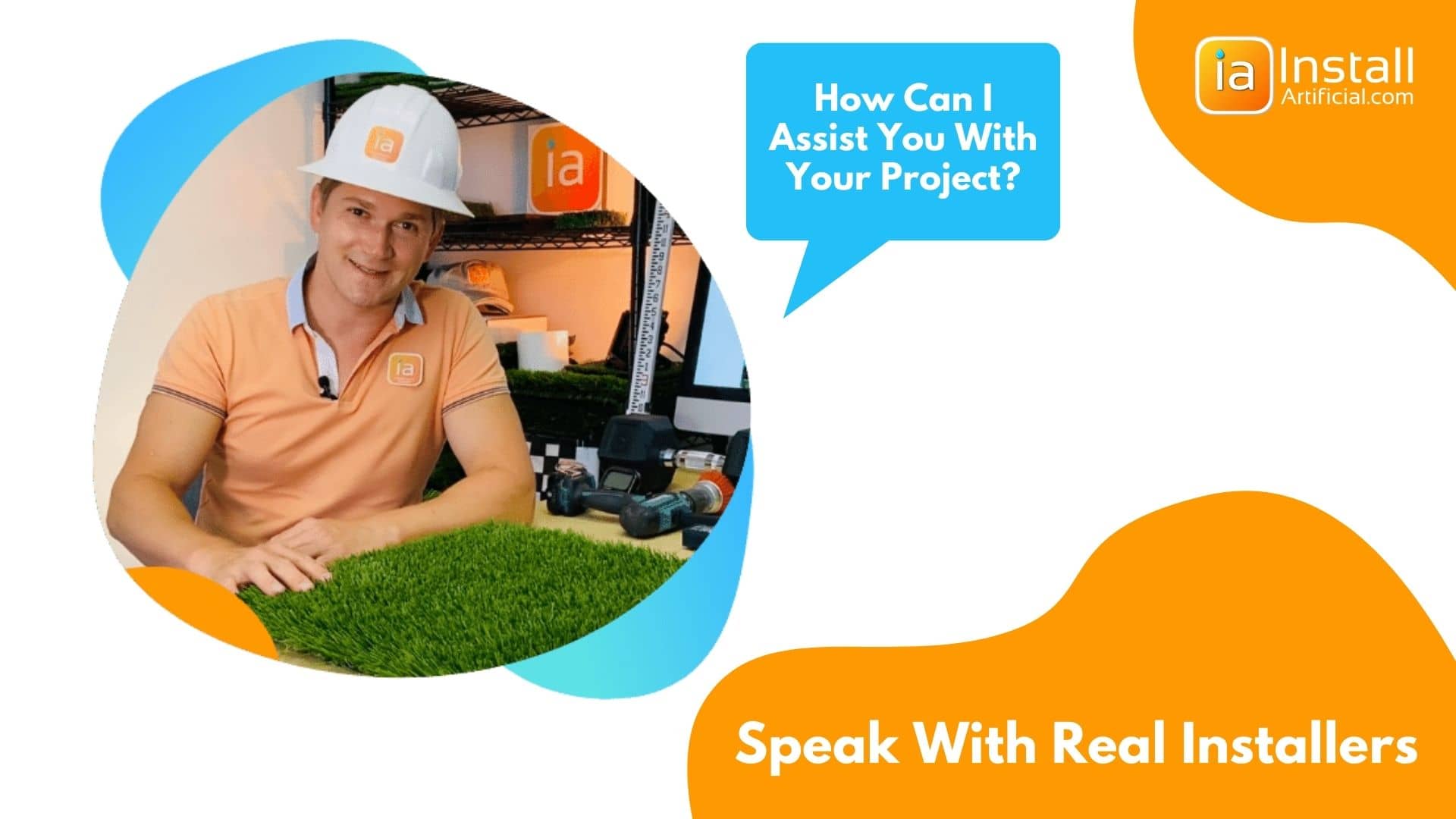
In our opinion, the best way to shop for turf is online. You can easily browse through options and narrow your search quickly. When shopping online for artificial grass, you can compare all types of artificial grass from multiple suppliers at once which typically isn't offered in-store. Also, you'll find more deals and promos online versus in-store. Whether you're doing DIY pet turf or a simple front lawn, you're sure to find grass that meets your needs and budget.
At InstallArtificial.com, we offer high-quality turf from 5 trusted suppliers with nationwide shipping. Products are categorized by brand and intended use for simplicity. We also administered a number of performance tests on each synthetic grass we offer such as wear-and-tear resistance and recovery rate so you can easily compare your favorites! Check out each product page to see their results!
Not every online turf supplier will offer high-quality and American-made products. Make sure to do your research when searching for artificial turf stores nearby to make sure they're trustworthy. Rely on customer reviews and feedback and always order samples before you buy.
DIY turf installation can really save you some money and is fairly straightforward. However, an easy way to ruin your investment is by installing the incorrect grass for your area. For areas with high foot traffic, stay away from tall and plush artificial grass because you'll run into premature matting and the blade structure will become compromised quickly. Pet-specific areas should feature antibacterial infills and grass with a shorter pile and less density for easier cleaning.
When ordering samples of your favorite contenders, the best way to assess their looks is by comparing them to natural lawns around your neighborhood. We'd also recommend setting them down on the ground and standing back about 10 ft. to really see their differences. It's from this view that you'll see the lawn fully installed and this will help you start to determine differences in texture, shape, and shade.
Adhesive - Products that use water to bond synthetic turf seams and inserts, usually made of urethane and/or epoxy. These adhesives can be used to attach synthetic turf to a base, though this is not always necessary.
Backing - Materials that make up the bottom layer of the grass and secure the blades.
Compaction - An increase in the density of something. Base materials will need to be compacted thoroughly to create a long-lasting installation. This prevents ground sinking or settling from occurring.
Density - Weight or mass per unit. Can also refer to the number of fibers and the closeness of tufts.
Drainage - Rate at which liquid percolates through the artificial grass. Drainage layers are designed to accelerate water movement underneath the synthetic turf.
Durability - The measure of resistance to wear and tear and environmental changes. Relating to the ability to endure.
Envirofill - An acrylic-coated synthetic turf infill. Helps moderate temperature and provides antibacterial properties – making it ideal for areas used by children and pets.
Face Weight - The weight of the fibers within the artificial grass, excluding the weight of the backing. Typically, this is measured in ounces per sq. yard. The higher the face weight, the more dense the material is.
Fall Zone Safety Rating - This means the artificial grass meets the ASTM guidelines to fall heights. Necessary for playgrounds and daycares, and recommended in areas where there's play equipment.
Filament/Fiber - Referring to an individual blade of synthetic turf.
Galvanized Nail - Zinc-coated nail used in construction that resists rusting. For turf installations, non-galvanized nails are ideal because the nails rusting help secure the installation.
Infill - Sand or rubber substance that's put on top of artificial grass. Infill is brushed into the blades to provide stability and cushion while also preventing wrinkles from occurring.
Luster - Shining by light reflection. To avoid luster, stay away from cheap or low-quality turf materials.
Magnification - When the sun is reflected off of one surface onto another. Magnification can cause artificial grass to melt if temps are too high. Reflections can be caused by second-story windows or stainless steel.
Matting - Process of the turf blades becoming tangled, flattened, and messy from foot traffic or other elements.
Nylon - Durable and resilient fiber, typically for a higher price point. The only turf material that will prevent magnification from occurring - nylon melting point is much higher than most magnifications can achieve.
Perforations - The holes in the backing that assist with drainage.
Permeable - Relating to whether or not a product can be penetrated by liquids or gas. If a turf's backing is fully permeable, it provides advanced drainage.
Pile Height - The height of the blades from the backing to the tip.
Polyethylene - One of the softest plastics. Used as a base product in face yarn. Most common yarn type.
Polypropylene - A coarse plastic, used in thatch or putting green materials.
Power broom - Professional tool used to brush the blades upright after installation. Also helps evenly distribute infill.
Seam - Where two pieces of artificial turf are connected. Most installers will seam in an "S" or zipper shape to help keep the seams invisible.
Silica Sand - The most common, affordable, and basic infill option. Made of broken down quartz and minerals.
Thatch - Textured yarn fibers, usually made of multiple colors that sit underneath the face blades to enhance recovery rate. Also helps turf appear more like natural grass.
Total Weight - The weight of the entire product, including face weight and backing.
Tufted - the process of manufacturing turf by feeding tufts through the backing material and making a loop to create the pile surface on top.
Zeolite - Fine substance that is spread along the surface, either underneath or on top, that helps prevent ammonia smells from pet use. Recommended in all pet turf applications.

What is artificial turf infill and why is it necessary in most artificial grass installations? Learn the different types of infill and compare your options to decide...
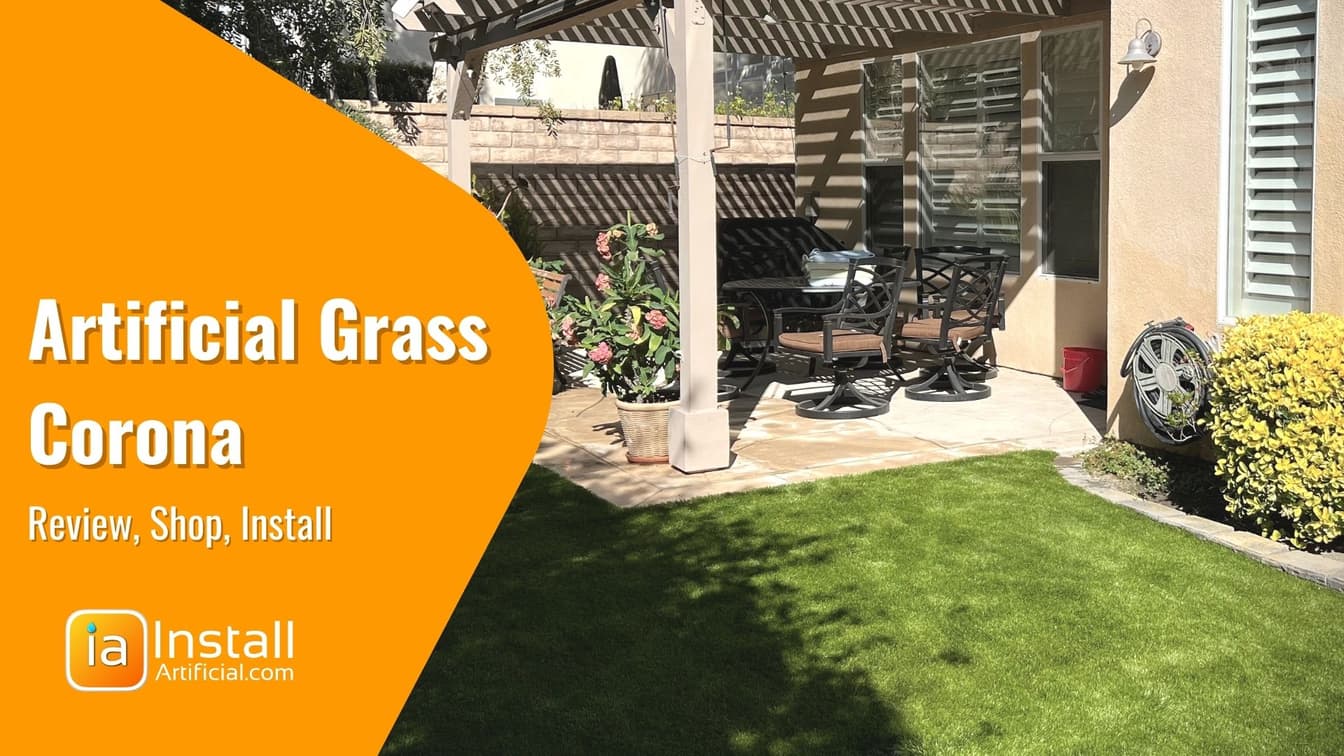
Learn how much artificial turf in Corona costs and what factors affect pricing.
>> Request a Custom Proposal for Your Specific Project in Just a Few Clicks